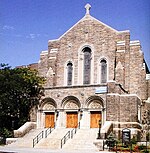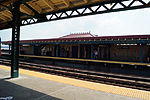Dyckman House
1784 establishments in New York (state)Broadway (Manhattan)Historic American Buildings Survey in New York CityHistoric house museums in New York CityHouses completed in 1784 ... and 6 more
Houses on the National Register of Historic Places in ManhattanInwood, ManhattanMuseums in ManhattanNational Historic Landmarks in ManhattanNew York City Designated Landmarks in ManhattanU.S. Route 9

The Dyckman House, now the Dyckman Farmhouse Museum, is the oldest remaining farmhouse on Manhattan island, a vestige of New York City's rural past. The Dutch Colonial-style farmhouse was built by William Dyckman, c.1785, and was originally part of over 250 acres (100 ha) of farmland owned by the family. It is now located in a small park at the corner of Broadway and 204th Street in Inwood, Manhattan.
Excerpt from the Wikipedia article Dyckman House (License: CC BY-SA 3.0, Authors, Images).Dyckman House
West 204th Street, New York Manhattan
Geographical coordinates (GPS) Address Nearby Places Show on map
Geographical coordinates (GPS)
| Latitude | Longitude |
|---|---|
| N 40.867361111111 ° | E -73.923055555556 ° |
Address
West 204th Street 663
10034 New York, Manhattan
New York, United States
Open on Google Maps








